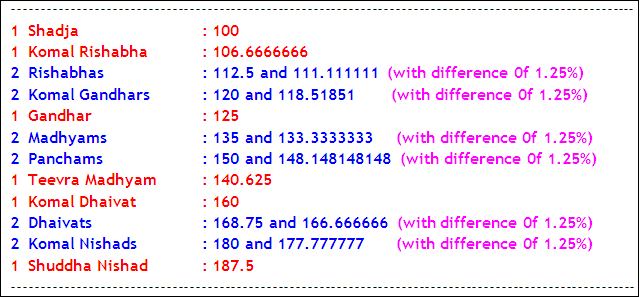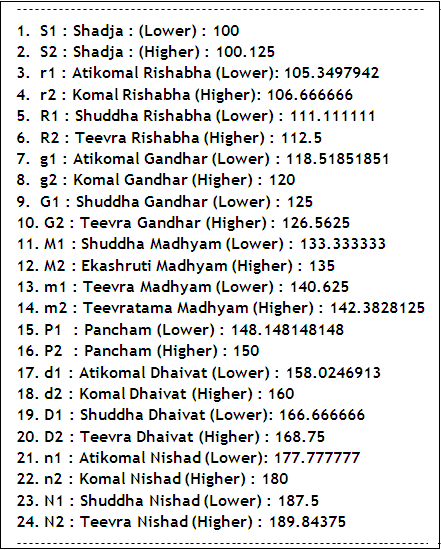22 shrutis evolve 'naturally' from Shadja : Gandhar : Pancham proportions.
Actually, Shadja leads to 24 Nadas, and 22 out of them are selected as 'Nyasa' positions or "Shrutis".
- 1Stage 1 :Production of 3 Basic/Natural shrutis - Shadja, Gandhar and Pancham
- 2Stage 2 : Production of 7 Basic/Natural shrutis or the Saptak - Shadja, Rishabha, Gandhar, Madhyam, Pancham, Dhaivat, and Nishad. We call these as 7 "Shuddha" swaras. And, because the 1st 6 Shrutis namely Rishabha, Gandhar, Madhyam, Pancham, Dhaivat, and Nishad take birth from Shadja, it is called as Shad (meaning 6) + Ja (meaning gives birth to) = Shadja.
- 3Stage 3 : Production of 24 shrutis and selection of 22 out of them.
Stage 1 : Production of 3 Basic/Natural shrutis - Shadja, Gandhar and Pancham
Let us first examine how are sounds produced in Nature. The simplest example of Natural sounds is those coming out of a single plucked string. Let us therefore take example a single string as a natural source of music. (We have already seen this in Topic 4)
Natural creation of 'Shadja' (Shruti No.1) : When a single string is plucked, it makes the 1st sound which we call as the "Shadja" or "Fundamental Tone", or 1st Harmonic. For the ease of understanding, let us consider the frequency of the Shadja as 100 hz.
So, when the string is plucked, the 1st sound of 100 hz is produced. Our brain is now set after hearing this sound, to an Octave or Saptak extending from 100 hz (Shadja) to 200 hz (Tara or upper Shadja). Thus, the string vibrates in 1 full part or the whole length of the string, to begin with, to produce the "Shadja" or "Fundamental Tone"; or the 1st Harmonic with a frequency of say, 100 hz.
(Immediately thereafter, as the energy put in the string for plucking reduces, the string starts vibrating in 2 parts. This produces a sound of 200 hz called as the 2nd Harmonic. This is "Tara Shadja" as we know. As Tara Shadja is exactly double of Shadja, this is not counted as a 'new' shruti.)
Natural creation of 'Pancham' (Shruti No. 2) : Immediately thereafter, as the energy put in the string for plucking reduces further, the string starts vibrating in 3 parts. This produces a sound of 300 hz called as 3rd Harmonic. This is however perceived by our brain as of 150 hz (our brain has the spectrum of perception of 100 hz to 200 hz) or "Pancham" (the 5th) as we know
(Immediately thereafter, as the energy put in the string for plucking reduces further, the string starts vibrating in 4 parts. This produces a sound of 400 hz called as 4th Harmonic. This is perceived by our brain as of 200 hz (our brain has the spectrum of perception of 100 hz to 200 hz) or Tara Shadja again. As Tara Shadja is exactly double of Shadja, this is not counted as a 'new' shruti.)
Natural creation of 'Gandhar' (Shruti No. 3) : Immediately thereafter, as the energy put in the string for plucking reduces further, the string starts vibrating in 5 parts. This produces a sound of 500 hz called as 5th Harmonic. This is perceived by our brain as of 250 hz or 125 hz (our brain has the spectrum of perception of 100 hz to 200 hz) or Gandhar.
After this stage, the energy put in the string for plucking reduces so much that further harmonics (6th, 7th, 8th and so on) are barely heard.
This process shows that the 1st 3 (different) Natural sounds created are always Shadja, Gandhar and Pancham at a ratio of 100 : 125 : 150. Therefore these 3 are the fundamental notes or 1st 3 Natural shrutis in Indian Classical Music.
Stage 2: Production of 7 Basic/Natural shrutis or the Saptak - Shadja, Rishabha, Gandhar, Madhyam, Pancham, Dhaivat, and Nishad. We call these as 7 "Shuddha" swaras.
Natural creation of 'Madhyam' (Shruti No.4) : After Shadja, Gandhar and Pancham are known, the 4th note is Madhyam. We know musically that Madhyam:Tara Shadja ratio/bhava/relationship is that of Shadja:Pancham i.e. 100:150. Now,Tara Shadja is 200. Therefore, Madhyam has to be 133.333333 so that this ratio is preserved.
Natural creation of 'Dhaivat' (Shruti No.5) : The 5th note is Dhaivat. We know musically that Dhaivat is the 'Gandhar' of 'Madhyam', or, musically Madhyam:Dhaivat ratio/bhava/relationship has to be that of Shadja:Gandhar i.e. 100:125. Since, Madhyam is at 133.333333, Dhaivat comes at 166.666666 to preserve this ratio.
Natural creation of 'Nishad' (Shruti No.6): The 6th note is Nishad. We know musically that Nishad is the 'Gandhar' of 'Pancham', or, musically Pancham:Nishad ratio/bhava/relationship has to be that of Shadja:Gandhar i.e. 100:125. Since, Pancham is at 150, Nishad comes at 187.5 to preserve this ratio.
Natural creation of 'Rishabha' (Shruti No.7): The 7th note is Rishabha. We know musically that Pancham:Rishabha ratio/bhava/relationship is that of Shadja:Pancham i.e. 100:150. Now,Pancham is 150. Therefore, Rishabha comes at 225 so that this ratio is preserved. 225 is the Tara Rishabha, hence, Rishabha in the original scale will be at 112.5.
Thus, the 1st 7 Natural sounds are produced as above. They create 3 (perfect) triads of Shadja:Gandha:Pancham, Madhyam:Dhaivat:Tara Shadja, and Pancham:Nishad:Rishabha; which are extremely harmonic and hence individually extremely melodic.
Stage 3: Production of 24 shrutis and selection of 22 out of them.
Shadja created Gandhar and Pancham (Stage 1), and ratios within them created 7 Natural shrutis (Stage 2). It is unbelievable but true that all the additional shrutis are actually the ratios within 7 Natural shrutis !
Creation of additional 'Rishabha' (Shruti No.8):Gandhar (125) / Rishabha (112.5) = 111.111111 %. This means that if Rishabha (112.5) is considered as Shadja, Gandhar (125 %) is perceived as additional Rishabha, and it comes at 111.111111.
Creation of 'Komal Gandhar' (Shruti No.9): Madhyam (133.333333) / Rishabha (112.5) = 118.51851851 %. This means that if Rishabha (112.5) is considered as Shadja, Madhyam (133.333333 %) is perceived as Komal Gandhar, and it comes at 118.51851851.
Creation of additional 'Pancham' (Shruti No.10): Dhaivat (166.666666) / Rishabha (112.5) = 148.148148148 %. This means that if Rishabha (112.5) is considered as Shadja, Dhaivat (166.666666 %) is perceived as Pancham, and it comes at 148.148148148.
Creation of 'Komal Nishad' (Shruti No.11): Tara Shadja (200) / Rishabha (112.5) = 177.777777 %. This means that if Rishabha (112.5) is considered as Shadja, Tara Shadja (200 %) is perceived as Komal Nishad, and it comes at 177.777777.
Creation of 'Komal Rishabha' (Shruti No.12): Madhyam (133.333333) / Gandhar (125) = 106.666666 %. This means that if Gandhar (125) is considered as Shadja, Madhyam (133.333333 %) is perceived as Komal Rishabha, and it comes at 106.666666.
Creation of additional 'Komal Gandhar' (Shruti No.13): Pancham (150) / Gandhar (125) = 120 %. This means that if Gandhar (125) is considered as Shadja, Pancham (150) is perceived as additional Komal Gandhar, and it comes at 120.
Creation of 'Komal Dhaivat' (Shruti No.14): Tara Shadja (200) / Gandhar (125) = 160 %. This means that if Gandhar (125) is considered as Shadja, Tara Shadja (200) is perceived as Komal Dhaivat, and it comes at 160.
Creation of additional 'Komal Nishad' (Shruti No.15): Tara Rishabha (225) / Gandhar (125) = 180 %. This means that if Gandhar (125) is considered as Shadja, Tara Rishabha (225) is perceived as Komal Nishad, and it comes at 180.
Creation of 'Teevra Madhyam' (Shruti No.16): Nishad (187.5) / Madhyam (133.333333) = 140.625 %. This means that if Madhyam (133.333333) is considered as Shadja, Nishad (187.5) is perceived as Teevra Madhyam, and it comes at 140.625.
Creation of additional 'Dhaivat' (Shruti No.17): Tara Rishabha (225) / Madhyam (133.333333) = 168.75 %. This means that if Madhyam (133.333333) is considered as Shadja, Tara Rishabha (225) is perceived as additional Dhaivat, and it comes at 168.75.
Creation of additional 'Madhyam' (Shruti No.18): Tara Rishabha (225) / Dhaivat (166.666666) = 135.
This means that if Dhaivat (166.666666) is considered as Shadja, Tara Rishabha (225) is perceived as additional Madhyam, and it comes at 135.
When the above 18 shrutis are arranged in a sequence, we realize that we have found:

Thus it can be seen that we have obtained from nature,
- 6 single shrutis (in red),
- 6 pairs of shrutis (in blue),
- And, the difference between each of the 6 pairs is exactly 1.25 % !!
Nature is in fact dictating that the difference between 2 shrutis (variants) for the same Swara should be 1.25 %! Hence, the missing partners of all 5 single shrutis are given by this difference of 1.25 %.
(For example, the missing partner of Komal Rishabha (106.666666) is at 105.3497942 because when 1.25 % is added to 105.3497942, we get 106.666666. Or, the missing partner of Gandhar (125) is at 126.5625 because when 1.25 % is added to 125, we get 126.5625.
Thus when all the 6 missing partners of 6 single shrutis are calculated, we get 24 shrutis as below :

Out of these 24 shrutis, 2 superfluous shrutis are discarded. They are No.2 : Shadja (Higher) at 100.125, and No.15 : Pancham (Lower) at 148.148148148; because, Shadja and Pancham have to be only at 100 and 150 respectively, and as they are 'fixed' (Achala) at these places in Hindustani Classical Music.
